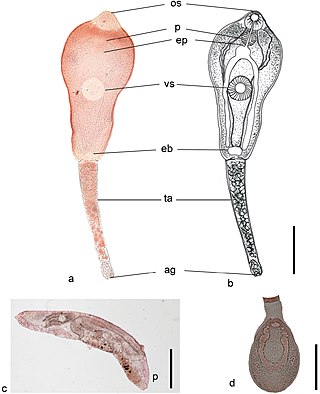
Trematoda is a class of flatworms known as flukes or trematodes. They are obligate internal parasites with a complex life cycle requiring at least two hosts. The intermediate host, in which asexual reproduction occurs, is usually a snail. The definitive host, where the flukes sexually reproduce, is a vertebrate. Infection by trematodes can cause disease in all five traditional vertebrate classes: mammals, birds, amphibians, reptiles, and fish.

Digenea is a class of trematodes in the Platyhelminthes phylum, consisting of parasitic flatworms with a syncytial tegument and, usually, two suckers, one ventral and one oral. Adults commonly live within the digestive tract, but occur throughout the organ systems of all classes of vertebrates. Once thought to be related to the Monogenea, it is now recognised that they are closest to the Aspidogastrea and that the Monogenea are more closely allied with the Cestoda. Around 6,000 species have been described to date.

The Aspidogastrea is a small group of flukes comprising about 80 species. It is a subclass of the trematoda, and sister group to the Digenea. Species range in length from approximately one millimeter to several centimeters. They are parasites of freshwater and marine molluscs and vertebrates. Maturation may occur in the mollusc or vertebrate host. None of the species has any economic importance, but the group is of very great interest to biologists because it has several characters which appear to be archaic.

Philophthalmus gralli, commonly known as the Oriental avian eye fluke, parasitises the conjunctival sac of the eyes of many species of birds, including birds of the orders Galliformes and Anseriformes. In Brazil this parasite was reported in native Anseriformes species. It was first discovered by Mathis and Leger in 1910 in domestic chickens from Hanoi, Vietnam. Birds are definitive hosts and freshwater snail species are intermediate hosts. Human cases of philophthalmosis are rare, but have been previously reported in Europe, Asia, and America.

Microcotyle is a genus which belongs to the phylum Platyhelminthes and class Monogenea. Species of Microcotyle are ectoparasites that affect their host by attaching themselves as larvae on the gills of the fish and grow into adult stage. This larval stage is called oncomiracidium, and is characterized as free swimming and ciliated.

Opecoelidae is a family of trematodes. It is the largest digenean family with over 90 genera and nearly 900 species, almost solely found in marine and freshwater teleost fishes. It was considered by Bray et al. to belong in the superfamily Opecoeloidea Ozaki, 1925 or the Brachycladioidea Odhner, 1905.

Satyu Yamaguti was a Japanese parasitologist, entomologist, and helminthologist. He was a specialist of mosquitoes and helminths such as digeneans, monogeneans, cestodes, acanthocephalans and nematodes. He also worked on the parasitic crustaceans Copepoda and Branchiura. Satyu Yamaguti wrote more than 60 scientific papers and, more importantly, several huge monographs which are still in use by scientists all over the world and were cited over 1,000 times each.

Hamacreadium is a genus of trematodes in the family Opecoelidae. It is synonymous with Olivacreadium Bilqees, 1976. Species of Hamacreadium are endoparasitic in fish such as Lethrinus Cuvier, 1829.
Cainocreadium is a genus of trematodes in the family Opecoelidae. It has been synonymised with Apopodocotyle Pritchard, 1966, Cainocreadoides Nagaty, 1956, and Emmettrema Caballero y Caballero, 1946.
Opecoelus is a genus of trematodes in the family Opecoelidae.
Pseudopecoelus is a genus of trematodes in the family Opecoelidae. It has been synonymised with Neopecoelus Manter, 1947.
Proterodiplostomidae is a monotypic family of trematodes in the order Diplostomida. It consists of one subfamily, Polycotylinae Monticelli, 1888, which consists of one genus, Cheloniodiplostomum Sudarikov, 1960, which consists of four species: Cheloniodiplostomum argentinense Palumbo & Diaz, 2018; Cheloniodiplostomum breve ; Cheloniodiplostomum delillei ; and Cheloniodiplostomum testudinis.
Fundulotrema is a genus of monogeneans in the family Gyrodactylidae.

Ancyrocephalidae is a family of monogenean flatworms. The family is considered as a "temporary name" in WorMS but includes a large number of genera and species.
Mexicana is a genus of monogeneans belonging to the family Ancyrocephalidae. All members of the genus are parasitic on fish.

Microcotyle archosargi is a species of monogenean, parasitic on the gills of a marine fish. It belongs to the family Microcotylidae. It was first described by MacCallum in 1913 based on ten specimens. Hargis (1956) pointed out that the description and figures given by MacCallum were poor in details.
Ototrema schildti is a species of trematode that parasitizes bats. It was described as a new species in 1978. O. schildti was first encountered in the intestine of a little brown bat in the U.S. state of Wisconsin. Little brown bats have the highest concentration of O. schildti in September and October. It can be a locally common parasite; in one population in Wisconsin, 97% of examined little brown bats were parasitized by O. schildti, with one bat containing 623 individuals.
Pseudomurraytrematoides is a genus of monopisthocotylean monogeneans, belonging to the family Diplectanidae.
Anchoromicrocotylinae is a subfamily of flatworms within the family Microcotylidae and class Monogenea. This subfamily was created by Bravo-Hollis in 1981, to accommodate Monogeneans recovered from the gills of Atractoscion nobilis (Sciaenidae) caught off California. In the same work, Bravo-Hollis in 1981 created the new genus Anchoromicrocotyle and amended the diagnosis of the family Microcotylidae. Members of Anchoromicrocotylinae differ from other Microcotylidae by the presence of a larval organ and larval hooks and the structure of the genital complex.
Pseudopodocotyle is a genus of trematodes in the family Opecoelidae. It consists of one species, Pseudopodocotyle bravoae.









